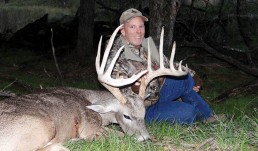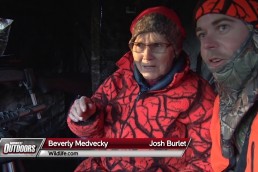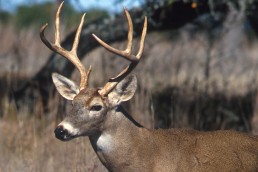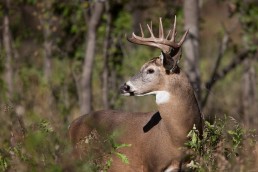When Deer Get Stupid
SHARE THIS POST
It’s common knowledge that a buck in rut is pre-occupied and vulnerable. And, this is when deer get stupid. Both sexes lower their defenses, as they are more concerned with procreation. If a deer hunter can read their body language, it is possible to increases the chances of taking a deer.
Knowledge of the body language of deer is important. And the non-verbal communication is just as important as the grunts and bleats.
Biologists tell us that the rut is triggered by the ratio of daylight to dark that the doe experiences. The doe begins to come into estrus when the days are shorter. Bucks are already in the mood for mating and take their cue from the doe’s body language. Even fawn bucks can show signs rut “behavior” if they are under a high-nutrition diet. The fawns do not obviously participate in breeding behavior until the second rut of their life.
During the breeding season, does are alert. If the doe is looking directly at the hunter, she will stomp her foot and snort. This is an attempt to identify you. She does not have your scent and she wants to get you to move so that she can see if you represent danger. She will train her eyes, ears and nose on you, and if you move, she will be gone.
If a deer flicks its tail, it is a clear signal that it plans to leave immediately. Seeing this action, you must decide to shoot or not. An alert deer is one with hair standing up. He is actually trying to make himself look bigger. And a buck running at a pacing trot is in pursuit of a hot doe. Preoccupied with the breeding behaviors, he becomes more vulnerable.
The preorbital and tarsal glands will tell a lot about a deer’s state of mind. The preorbital gland is located in the corner of the eye closest to the nose. The tarsal gland is that sack-like growth on the inside of the rear leg hocks. If either gland is open, then the deer is in a stressed condition, and are either angry or scared.
Does with tarsal glands that are flowered or open will probably be followed by a buck or a predator. Buck hunters should be alert to the approach of does in heat in order to ambush the buck that is following. Dark tarsal glands on a doe indicate she is in heat. A buck will not be far away.
Are you enjoying this post?
You can be among the first to get the latest info on where to go, what to use and how to use it!
If two bucks are facing off, the one that breaks eye contact first is the submissive buck. The dominant buck will drive him away. The direction the submissive buck turns is the direction in which he will leave. The dominant buck will follow. By being able to predict the path of escape, hunters can prepare for a shot that may then be presented.
Determining when deer are going to leave is often as simple as listening for a snort. The snort-wheeze is the last act of aggressive behavior. This is when the animal will likely fight or flee.
Bowhunters should observe the demeanor of deer. A deer that is nervous will “jump the string.” But the action of a deer in response to the sound of an arrow leaving a bow actually produces a “ducking action,” as deer do not jump when they are standing flat-footed. They have to drop down, or duck, to get enough spring in their legs to jump.
Knowing the difference between a calm deer and one that is nervous signals the archer whether to shoot low or not. Again, if it’s nervous, the deer will drop down and the hunter needs to aim about 6 inches lower. If the deer is calm, then the hunter can aim at the kill zone.
Finally, if you are successful in putting a deer on the ground, it is important to approach him with caution. “Dead” deer that get up and attack anyone near them injures hunters every year. Look at the animal’s eyes. If they are closed, he is not dead. All deer die with their eyes open.
Don Gasaway is a veteran outdoor writer from Marion, Ill. He may be contacted at dongasaway.wordpress.com or facebook.com/DonsJournal.
MWO
SHARE THIS POST
Did you enjoy this post?
You can be among the first to get the latest info on where to go, what to use and how to use it!
Don Gasaway
Don Gasaway is a veteran freelance outdoor writer from Marion, Ill. He may also be found at: https://www.facebook.com/DonGasawayWriter and facebook.com/Wandering Angler. Comments are welcome



